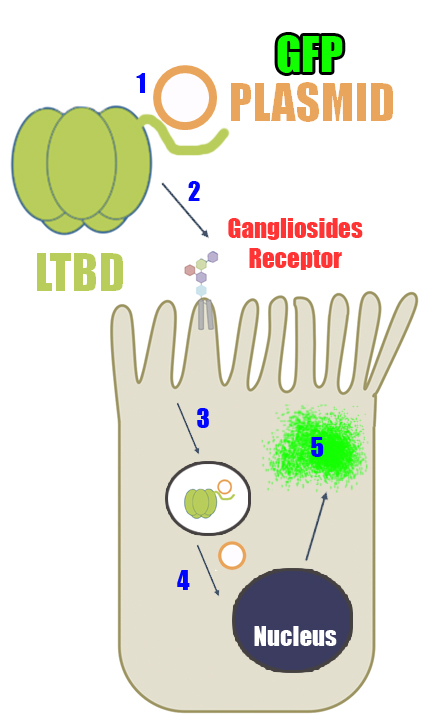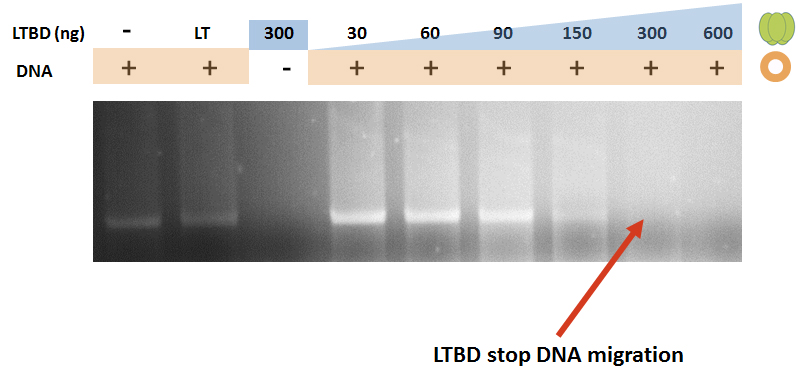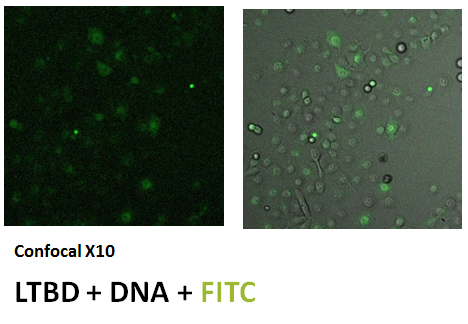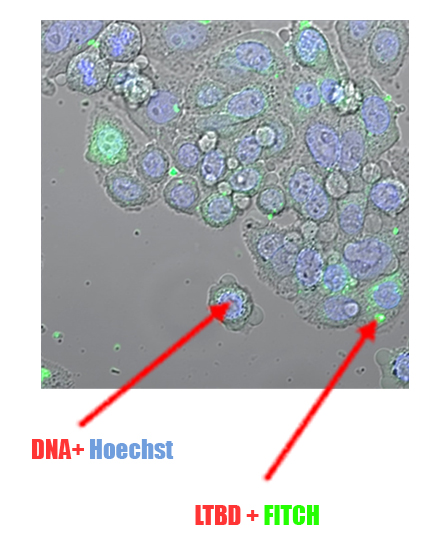| (2 intermediate revisions by the same user not shown) | |||
| Line 1: | Line 1: | ||
| − | {{Tel-Hai}} | + | <html><link rel="stylesheet" type="text/css" href="https://2016.igem.org/Template:Tel-Hai/CSS?action=raw&ctype=text/css" /> |
| + | <img id="topimg" src="https://static.igem.org/mediawiki/2016/8/8b/T--Tel-Hai--dna.jpg" /> | ||
| + | </html> {{Team:Tel-Hai/Header}} <html> | ||
| − | < | + | <h3>Demonstrating A Proof of Concept</h3> |
| + | <div class="proof"> | ||
| + | <p class="lead">In order to explain our proof of concept, it's necessary to remind ourselves the main project goal: <strong>"Development of a novel and <span style="color: red;">efficient delivery-system</span> for gene editing technology in Cystic Fibrosis"</strong></p> | ||
| + | <h4>Work Plan:</h4> | ||
| + | <ol> | ||
| + | <li>BBa_K2061005 consist: B-subunit of the E. coli Heat-Labile Toxin (LTB), linker and short viral DNA binding domain (DBD) sequences, expression via pSB1C3 plasmid in E. coli.</li> | ||
| + | <li>Isolation of the new chimeric protein: LTB + DBD (LTBD).</li> | ||
| + | <li>LTBD binding to GFP plasmid.</li> | ||
| + | <li>LTBD + plasmid enter the cell when introduced to NCI-H1650 (human lung epithelial cells expressing ganglioside receptors on their plasma membrane).</li> | ||
| + | </ol> | ||
| + | <p><small>* LTBD complex was pre incubated with and plasmid tagged with Hoechst for identification.</small></p> | ||
| + | <h4>Our Proof of Concept Goals:</h4> | ||
| + | <p>LTBD binding, delivery and expression of GFP plasmid to NCI-H1650: | ||
| + | <ol> | ||
| + | <li>LTBD bind GFP plasmid DNA</li> | ||
| + | <li>LTBD bind to ganglioside receptor</li> | ||
| + | <li>LTBD + GFP plasmid enter the cell via endocytosis</li> | ||
| + | <li>Plasmid go to the nucleus</li> | ||
| + | <li>GFP gene expression</li> | ||
| + | </ol></p> | ||
| − | <div class=" | + | <div class="image-holder"><img src="/wiki/images/7/72/T--Tel-Hai--proof1.jpg" /></div> |
| − | + | <p><strong>Results:</strong> | |
| − | + | <ol> | |
| − | <p> | + | <li>LTBD stop DNA migration by binding to the plasmid. |
| − | + | <div class="image-holder"><img src="/wiki/images/f/fc/T--Tel-Hai--proof2.jpg" /></div></li> | |
| − | </ | + | <li>LTBD with marked with green FITC attaching to cell membrane |
| − | + | <div class="image-holder"><img src="/wiki/images/a/a1/T--Tel-Hai--proof3.jpg" /></div></li> | |
| − | + | <li>LTBD in cell's cytosol</li> | |
| − | < | + | <li>DNA in the nucleus |
| − | < | + | <div class="image-holder"><img src="/wiki/images/2/25/T--Tel-Hai--proof4.jpg" /></div></li> |
| − | + | ||
| − | </ | + | |
| − | + | ||
| − | </div> | + | |
| − | + | ||
| + | <p><small>* We were unable to achieve the 5th goal due lack of time.</small></p> | ||
| + | <p><strong>We want to thank Dr. Moshik Kutner-Cohen and Dr. Niv Bachnoff for guiding us to achieve all above.</strong></p> | ||
</div> | </div> | ||
| − | </html> | + | </div></html> |
Latest revision as of 12:03, 19 October 2016

iGEM Tel-Hai 2016
Demonstrating A Proof of Concept
In order to explain our proof of concept, it's necessary to remind ourselves the main project goal: "Development of a novel and efficient delivery-system for gene editing technology in Cystic Fibrosis"
Work Plan:
- BBa_K2061005 consist: B-subunit of the E. coli Heat-Labile Toxin (LTB), linker and short viral DNA binding domain (DBD) sequences, expression via pSB1C3 plasmid in E. coli.
- Isolation of the new chimeric protein: LTB + DBD (LTBD).
- LTBD binding to GFP plasmid.
- LTBD + plasmid enter the cell when introduced to NCI-H1650 (human lung epithelial cells expressing ganglioside receptors on their plasma membrane).
* LTBD complex was pre incubated with and plasmid tagged with Hoechst for identification.
Our Proof of Concept Goals:
LTBD binding, delivery and expression of GFP plasmid to NCI-H1650:
- LTBD bind GFP plasmid DNA
- LTBD bind to ganglioside receptor
- LTBD + GFP plasmid enter the cell via endocytosis
- Plasmid go to the nucleus
- GFP gene expression

Results:
- LTBD stop DNA migration by binding to the plasmid.

- LTBD with marked with green FITC attaching to cell membrane

- LTBD in cell's cytosol
- DNA in the nucleus

* We were unable to achieve the 5th goal due lack of time.
We want to thank Dr. Moshik Kutner-Cohen and Dr. Niv Bachnoff for guiding us to achieve all above.

